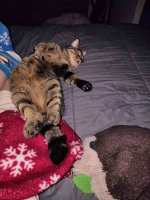Tyleete
Member Since 2025
Yesterday
@Wendy&Neko Maddie was showing me Kai's spreadsheet, and she doesn't go crazy with the ear sticks. Is it possible to do this? To go the TR route with no more than 7 a day unless there's a scary reading? Cause she showed me how well Kai has done since switching. Though in truth, I really didn't see much of a difference in the use of insulin? I was seeing some TR ss that averaged 12-14 sticks per day even when there were no concerning looking numbers and that scared me.
Thanks!
@Wendy&Neko Maddie was showing me Kai's spreadsheet, and she doesn't go crazy with the ear sticks. Is it possible to do this? To go the TR route with no more than 7 a day unless there's a scary reading? Cause she showed me how well Kai has done since switching. Though in truth, I really didn't see much of a difference in the use of insulin? I was seeing some TR ss that averaged 12-14 sticks per day even when there were no concerning looking numbers and that scared me.
Thanks!

